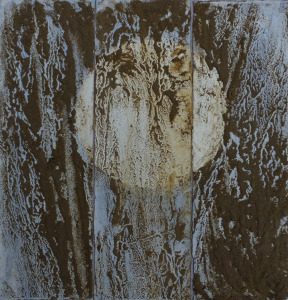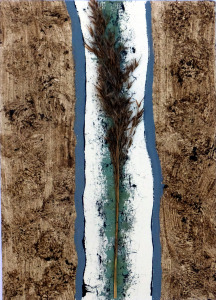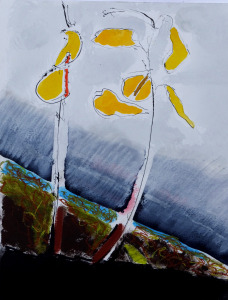This post comes to you from EcoArtScotland
David Borthwick, who runs the University of Glasgow’s masters programme Environment, Culture and Communication at the university’s Dumfries Campus, reviews Lydia Fulleylove’s Estuary, a new book of poems published by the excellent Two Ravens.
Estuaries are, as in the title of one of Raymond Carver’s stories, ‘where water comes together with other water,’ fresh into salt, and as estuaries are characterised by tidal influx, where salt reaches back upriver. They are transitional zones where local systems meet global ones, the activities of the land meet the open sea; indeed, they are also open to the tractive pull of moon and sun, linking them to celestial bodies too.  An estuary is defined by relational forces, then, and this also makes it a profoundly susceptible space. One might say an estuary is produced through its myriad relations.

Colin Riches, ‘moon and stream’, silt, oil and acrylic
Estuaries are profoundly cosmopolitan areas, rich in the symbolism of transition, and this is perhaps why these environments have proven fertile grounds for poets in recent years. The Severn estuary, in particular, has received considerable attention in both
Alice Oswald’s book length
A Sleepwalk on the Severn, and
Philip Gross’ collection
The Water Table (both 2009). Oswald refers to ‘this beautiful / Uncountry of an Estuary’.
[1] Her ‘uncountry’ is ‘both a barren mudsite and a speeded up garden’. It is between, untenable, and indefinable, irreducible to notions of rootedness, permanence or stability. Phillip Gross describes an estuary in terms of its ‘indefinite grounds’, characterised by ‘constant inconstancy’; its ‘indefinable grounds’ and ‘irrefutable grounds’: ‘six hours and the grounds / are remembered. Forgotten. Remembered’.
[2]
Lydia Fulleylove’s Estuary, published by Lewis based Two Ravens Press, adds to but also enlarges this resurgent interest in estuaries. Centred on the River Yar estuary in the west of the Isle of Wight, Fulleylove’s eclectic book demonstrates in its very form the power of relationality. The book is part nature daybook—a diary of visits to the estuary, interactions with it over the course of a year—but also a poetry collection. It also has elements of deeply personal memoir. One of the book’s strengths is that Fulleylove cannot bracket off her personal relations (an aging father during illness), her job as a creative writing tutor at HMP Isle of Wight, nor indeed the politics which sees one of the estuary’s farms carefully dismantled during her period of residency in the area. It is all of a part, each element a channel or rivulet in the book’s flow outwards. This is only added to by Colin Riches’ contribution of artwork at the collection’s centre: pictorial representations of estuary features, animals (domestic and wild), and artefacts. Many of these have been created using materials from the estuary as their medium: estuary mud, sheep dung, bramble juice.
Fulleylove and Riches employ sensory information as a key part of their work here. In one poem, the artist is observed at work:
Dung, mud, ink. The artist makes
the cow in the winter barn,
legs tucked under like a cat,
tail pressed close. Black eye watchful,
nostrils, ears flared. Long after
she is gone, these marks will call up her absence,
draw her presence out of dark.
This attempt to capture presence is vital, poetic and visual work going hand in hand as a means of representing the estuary faithfully, even as the environment shifts around one with the tide:
cracked mud mud-gasps
river dark glass
look down clouds sky
look up clouds sky
here is river
see sea-river
The stutters and repetitions here enact not only the process of trying to write the estuary, but its own particular and fluid behaviour. Everything described must relate to the estuary, the estuary itself formed by these relations, and with all being fluid this negotiation even reaches into the language that Fulleylove uses. The process of rounding up sheep is rendered in riverine terms. Sheepdogs are:
Swift, slick
they whip round the sheep,
close to the ground. The flock
runs like a river into the pen
any stray rivulet
channelled back in.
It’s done almost before it’s seen.

Colin Riches, ‘Reed and River’, reed, earth, ink and gouache
What separates Fulleylove’s book from some of the celebrated ‘New Nature Writing’ is that it continually brings the reader back to community, away from the writer’s solitary observations and into the eddies and turbulence of issues affecting wider concerns. Local writers’ and artists’ groups are taken out into the estuary to experiment. Farmers’ views are recorded verbatim and inserted into poems. Most powerfully, the estuary is brought indoors in order to engage prisoners with an external environment they cannot access. Among the artefacts offered to prisoners are leaves: ‘what the men most want to do with the leaves is to smell them. A leaf is passed round nose to nose.’ Sensory apprehension again. The prisoners’ reflections in their own writing are recorded here too.
There is a powerful social justice imperative within the book, from the treatment of the poet’s father in institutional care, to the politics of landscape which places farmland in ownership that cares not for local experience and traditions— and of course to the welfare of those in prison.
Estuary tacitly suggests that all of Fulleylove’s concerns are intimately connected. Indeed, connection is a recurring motif. A Schoolgroup is taken to see the last of the farm’s animals as it is transformed from an Aberdeen Angus carcass to food. The visit is meant to reconnect the children with the food chain because, as Fulleylove notes, ‘we can’t be disconnected from this earth’.

Colin Riches, ‘Last Year’s Leaves’, mixed media
And yet because we are ‘wrapped in layers of distance’ from the nonhuman world, and perhaps from each other, we ignore the interconnections which inform and shape us all. From the flora and fauna of the estuary, to the farms upon it, and even the prison, relations exist which conjoin to form a relational space. In short, the estuary, this place, exists only as the total interactivity of these factors. There is no ‘inside’ and ‘outside’, but a reciprocal set of interactions in which we are all enmeshed. In Fulleylove’s thoughtful book, the estuary becomes a powerful symbol for relations and responsibilities.
Indeed, in her prologue Fulleylove says that all of the book’s segments exist as ‘as sign of having been there, evoking the relationship with place at that moment’. The work is, she says, ‘a dialogue’; it is all about ‘the act of paying attention’: using the senses, different materials, extending empathy to the lives of others, both human and non-human.
In a relatively slight book of under a hundred pages, Fulleylove manages to weave together all of the elements of the local environment on the Yar estuary. Her vision is clear, her work concise and potent. She is capable of reflecting back and forth in landscape, and in time, in a way that makes the book more than a diary of a specific place, but an exploration of a place’s multiplicity through the seasons, in which every detail is made to resonate, and flow outwards from itself:
I pick one barley stalk from this dry sea
to stick on the white field of my page.
Winter, I’ll look back at slant, hard-packed grain,
like Brent geese streaming in close line.
[1] Alice Oswald, A Sleepwalk on the Severn (London: Faber, 2009), p. 3.
[2] Philip Gross, ‘The Water Table (Tarset, Northumberland: Bloodaxe, 2009), pp 47-48.
ecoartscotland is a resource focused on art and ecology for artists, curators, critics, commissioners as well as scientists and policy makers. It includes ecoartscotland papers, a mix of discussions of works by artists and critical theoretical texts, and serves as a curatorial platform.
It has been established by Chris Fremantle, producer and research associate with On The Edge Research, Gray’s School of Art, The Robert Gordon University. Fremantle is a member of a number of international networks of artists, curators and others focused on art and ecology.
Go to EcoArtScotland
Powered by WPeMatico






 Â Â Â
       Â
       Â
        Â
      A new website for reusing theatrical goods
A new website for reusing theatrical goods






 Art, Activism, and EcoJustice Education
Art, Activism, and EcoJustice Education